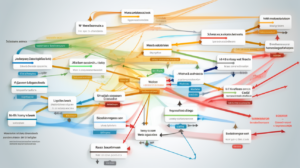Qualitative backlinks and where to find them

In today's digital world, the competition for users„ attention is fiercer than ever. Companies, bloggers and webmasters are constantly looking for effective ways to improve their online presence. One of the proven methods to achieve this goal is high-quality backlinks. But what makes a backlink “high quality"? And how can quality backlinks help your website rank higher in search engines?
This article aims to give you a comprehensive overview of the topic of „high-quality backlinks“. We will explain the importance of backlinks in the context of SEO (search engine optimization), show you how you can recognize high-quality backlinks and present methods on how you can gain such links for your website.
So if you want to take your website to the next level, then this article is for you. Without further ado, let's dive into the world of high-quality backlinks!
What are backlinks?
Backlinks, also known as inbound links, are links from one website to another. They play a crucial role in the world of SEO (search engine optimization). Search engines like Google use backlinks as a kind of referral system. If your website is linked to by another high-quality website, Google sees this as a positive sign of trust and rewards your site with a better ranking in the search results.
Types of backlinks
There are different types of backlinks, each of which can have different effects on your SEO:
- Dofollow linksThese links transfer „linkjuice“ and can positively influence your search engine rankings.
- Nofollow linksThese links do not transfer „linkjuice“, but can still provide more traffic and credibility.
- Ugc links (User Generated Content)These links originate from content that users have created themselves, such as comments or forum posts.
- Sponsored Links: These are paid links that start with a
rel="sponsored"tag to indicate to search engines that this is a paid link.
Why are backlinks important for SEO?
Backlinks are important for several reasons:
- Building trustHigh-quality backlinks from authoritative websites increase trust in your website.
- RelevanceBacklinks from thematically relevant websites show Google that your website is relevant in a certain area.
- Traffic: Aside from SEO, quality backlinks can also drive traffic directly to your website, which in turn can lead to more leads and sales.
Quality vs. quantity
In the past, the number of backlinks was often the decisive factor for a good ranking in the search engines. Today, however, the focus has shifted. Search engines such as Google are placing more and more emphasis on the quality of the backlinks that point to a website. But what exactly does this mean?
Why high-quality backlinks are better
- Lower risk of penaltiesWebsites with many low-quality backlinks run the risk of being penalized by Google. High-quality backlinks minimize this risk.
- Higher conversion ratesUsers who reach your site via a high-quality backlink are often more relevant to your business and therefore more likely to be interested in your products or services.
- Stronger brandingA backlink from a reputable website can significantly increase the reputation of your own brand.
How many high-quality backlinks do you need?
There is no fixed rule as to how many high-quality backlinks you need for a successful SEO strategy. It depends on various factors, such as the competition in your industry and the current state of your SEO. The key is to continuously gain high-quality backlinks rather than focusing on sheer numbers.
How do you recognize high-quality backlinks?
The quality of a backlink is not always obvious at first glance. However, there are some criteria that can help you to differentiate between high-quality and low-quality backlinks.
Relevance of the linking page
A high-quality backlink usually comes from a website that is thematically relevant to your own site. For example, if you run a website about pet care, a backlink from a veterinary website would be more valuable than one from a website about car repairs.
Authority of the linking page
The authority of the linking website is another important factor. Websites with high authority usually have many high-quality backlinks themselves and therefore offer more „link juice“. Tools such as Moz's Domain Authority or Ahrefs‘ Domain Rating can help you to evaluate the authority of a website.
Position of the backlink on the page
Not all backlinks are created equal, even if they come from the same website. A backlink that is placed in the main content of the page is usually more valuable than a link that is hidden in the footer or sidebar.
Other factors
- Anchor text: The text used for the link should be relevant to the target of the linked page.
- Follow vs. no-followAs already mentioned, follow links are generally more valuable, but no-follow links also have their place in a balanced backlink strategy.
- Website trafficA backlink from a website with high traffic can bring more visitors to your site and is therefore often more valuable.
In the next few sections, we will look at different methods of gaining such high-quality backlinks for your website.
Methods for obtaining high-quality backlinks
There are many strategies for gaining high-quality backlinks. Some are time-consuming, while others require less effort. Here are some of the most effective methods:
Guest contributions
Writing guest posts for other blogs or websites is one of the most popular ways to get quality backlinks. The key here is to find websites with high authority and relevance to your industry.
Broken Link Building
This method involves finding broken links on other websites and offering your own content as a replacement. This is a win-win situation: the other website gets a working link, and you get a high-quality backlink.
Skyscraper technology
This technique requires you to create premium content that is better than the current best resources on a particular topic. You then contact websites that link to the lesser resources and offer your own content as a better alternative.
Social Media
Although most social media links are „no-follow“, they can still drive traffic to your website and increase visibility, which can indirectly lead to more high-quality backlinks.
Influencer outreach
Including influencers can not only give your content more credibility, but also increase the likelihood that other high-quality websites will link to you.
Local partnerships
For local businesses, partnering with other local businesses can be a great way to get quality backlinks. It's also a great way to network.
Tools for analyzing backlinks
Obtaining high-quality backlinks is only half the battle. To really measure the success of your backlink strategy, you need the right tools to analyze it. Here are some of the best tools that can help you do this:
Ahrefs
Ahrefs is one of the most comprehensive SEO tools on the market. It provides detailed information about the backlinks pointing to your website, including the quality and number of links.
Moz
Moz is another popular SEO tool that offers a range of features, including the ability to check the „domain authority“ of a website. This can give you a good indication of the quality of a potential backlink.
SEMrush
SEMrush offers a backlink analysis feature that helps you monitor your backlinks and those of your competitors. It also offers a range of other SEO features that can be useful.
Google Search Console
Google Search Console is a free tool from Google that provides basic information about the backlinks to your website. It is less detailed than the other tools, but a good starting point.
How to interpret the data
Interpreting the data can be overwhelming at first. Important metrics to look out for are:
- Number of backlinksAn indicator for the popularity of your website.
- Quality of the backlinksCheck the domain authority and relevance of the linking websites.
- Anchor textsThese should be diverse and relevant to the content of your website.
Risks and how to avoid them
While high-quality backlinks offer many benefits, there are also risks that you should be aware of and avoid. Here are some of the most common pitfalls and how you can avoid them:
Google penalties
Google has strict guidelines for what it considers „unnatural“ backlinks. If your website has a lot of low-quality or bought links, you could risk a penalty. To avoid this:
- Check your backlink profile regularly.
- Use the „Disavow“ function in the Google Search Console to remove harmful links.
Negative SEO (search engine optimization)
This is an unethical tactic where someone intentionally creates low-quality backlinks to your website to hurt your rankings. To protect you from this:
- Monitor your backlink profile regularly.
- Use the „Disavow“ function for all harmful links that you did not create yourself.
Over-optimized anchor text
If all your backlinks use the same anchor text, this could be considered spam. Make sure to use a variety of anchor texts that are natural and relevant.
Rapid accumulation of backlinks
A sudden increase in the number of backlinks could be seen as spam activity. Try to let your backlinks grow naturally over time.
By knowing these risks and taking proactive steps to avoid them, you can ensure that your backlink strategy is not only effective but also sustainable.
Case studies
- Study by eology GmbH
- ContentsThis study by Backlinko examines the influence of backlinks on Google rankings. It shows a correlation between the overall „link authority“ of a website and better rankings. Sites with more backlinks tend to have a higher ranking.
- FindingsThe study emphasizes that backlinks from many different websites are important. Other ranking factors are text length, content depth and title tags.
- Source: eology.de
- Case study from The Upper Ranks
- ContentsThis case study describes the experiences of an SEO expert who launched a new website in the healthcare sector. He created 26 pieces of high-quality content, but did not build any backlinks. After a year without traffic, he started building links.
- Results: After link building, traffic increased significantly. A total of 103 high-quality links were built.
- Source: theupperranks.com




